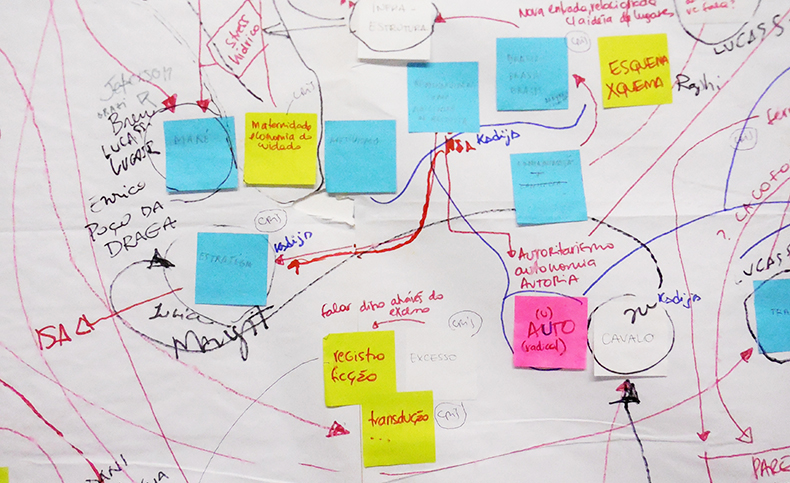
Diagram of the project Vocabulário político para processos estéticos (A Political Vocabulary for Aesthetic Processes). Capacete, Rio de Janeiro, 2014.
Intersecting Vocabularies: A Transversal of Brazil Between “Disruptive Junes”
Cristina Ribas
The political imagination unlocked itself and produced an incision in political time.”
Peter Pál Pélbart, Eu sou ninguém (I Am No One), 19/07/20131
Sections of the Text
1. Presentation
2. Language, Idiom, Financial Capitalism: Seizures and Proliferations of Meaning
3. Transversality
4. Method and Methodologies: A Transforming Encounter?
5. The Invention-Book and A Few Intersections
1. Presentation
This text designs an analytic and narrative cartography of the process of creating the book Vocabulário político para processos estéticos (A Political Vocabulary for Aesthetic Processes), which I conceived and edited, and which included the participation of more than 30 authors – diverse artists, researchers and activists throughout Brazil. The process of creating the book began in Rio de Janeiro, with funding from Funarte (Brazil’s national Foundation for the Arts) through the 2013 Redes Grant. The book arose in the midst of a cycle of protests that questioned a series of anti-democratic and neo-developmentalist policies in Brazil, culminating in what has been called, variously, June Journeys, Brazilian Spring, June Cycle, and Disruptive June, among other names.2 The book is the homonym of a project that took place through diverse encounters in April 2014. Vocabulário político was launched in January 2015 with free distribution. It can also be downloaded here (Portuguese only). This text is itself a cartography, in that, it narrates part of the bookmaking process, brings up a few marks of this process and opens new paths for investigation.
The conception of Vocabulário político para processos estéticos took place in parallel to a cycle of protests that broke out in Brazil beginning in mid-April 2013, with the first protests of the Free Pass Movement MPL (Movimento Passe Livre)3 in the cities of Porto Alegre, Florianópolis and Salvador. The initial objective of this project was not primarily to serve as a strategy connected to the cycle of protests. Instead, it aimed at creating a strategy of provoking a species of transversals a crossing-over between creative and political spaces in certain circles of aesthetic and political production in Brazil that had also become mobilized by the cycle of protests. The project’s central objective was to map concepts and practices through an encounter of differences, through a multiple (or diverse) collective, with participants from various parts of the country.4 By collecting concepts and practices that the participants brought together, the book became a product beyond-vocabulary, an archive and a toolbox for collective processes.5 6 However, the way we dealt with these concepts was not based on the sort of objectivity one might encounter with other toolboxes, we let ourselves drift and detour, playing with possible and unlikely connections, for example the word infrastructure linked with maternity, opening up new political readings and interconnections. We produced entry-concepts that could lead the reader to discover other points of departure or other tools; in other words, our tollbox created intersections with other vocabularies, and between vocabularies.
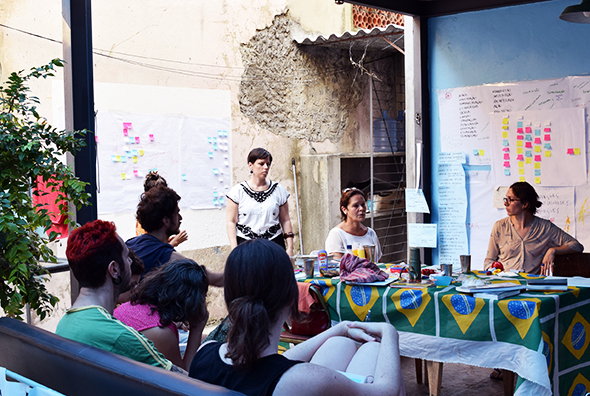
The project Vocabulário político para processos estéticos in process. Capacete, Rio de Janeiro, 2014.
Political vocabulary is therefore an invention-book with more than 30 expressed in diverse languages, making use of narratives, personal accounts, critical and theoretical arguments, fiction, diagrams, poetry and images, among other forms. A major part of this content arises with, or passes through, the Disruptive Junes. Meanwhile, this current text follows two questions or presuppositions that I examine in the book’s Editorial/Dis-editorial, investigating especially the concept of “transversality” and our possibility of making vocabularies “intersect”. The two questions that I examine in the Editorial are centred on both the “making” of a vocabulary (“how can we make a vocabulary?” or its method) as well as on its effects (“what does a vocabulary want to make?”). By moving myself between these two questions, I aim to open analyses regarding the effects of Political vocabulary in the political and cultural context of today’s Brazil.
Here, I consider the concept of “transversality” through the practice of “cartography” as conceptualized by Félix Guattari and Suely Rolnik, further developed in Brazil today in “transversalist” academic research by scholars including Virgínia Kastrup, Eduardo Passos, Regina Benevides de Barros and Tania Maria Galli da Fonseca, among many others.7 The concept of “intersectionality,” for its part, arises from feminist struggles and from the necessity of removing “white feminism” from a central position in these struggles to create space for an “intersectional feminism”8. The objective of “intersectionality” is to create passages, crossings or lines of solidarity between diverse struggles including those that are constituted around notions of race, sexuality, class and gender. In this text, I will not investigate “intersectional feminism”, but I will appropriate the concept of intersectionality without removing it from its political background, while trying to activate it in the space and mode of happening for our Vocabularies.
The analysis of the process of constructing the book is, in practice, the investigation of the possibility of applying transversality and activating intersectionality in encounters such as this one: encounters that seek to produce by putting artistic and political practices into contact with each other, as well as by including other practices, such as the educational, mediatic and philosophical.9
In order to make the book, I invited people or groups whose practices arise, in large part, from hybrid places, who rehearse and perform interventions in fields of diverse areas of knowledge, or through transversals among and between idioms.10 These people produce art, radical strategies for research, knowledge production and learning, and urban interventions. They create various dispositifs: performances, political and social mobilizations and translations; they organize books, participate in popular education groups, organize co-research workshops, vegan festivals, digital culture festivals, critical cartography festivals and they give horseback riding lessons, among other activities.
I invited the Agência Transitiva collective, as well as several individuals: Andre Basséres, André Luiz Mesquita, Beatriz Lemos, Breno Silva, Cecília Cotrim, Davi Marcos, Daniela Mattos, Enrico Rocha, Giseli Vasconcelos, Graziela Kunsch, Inês Nin, Isabel Ferreira, Jeferson Andrade, Julia Ruiz, Juliana Dorneles, Kadija de Paula, Laura Lima, Lucas Rodrigues, Lucas Sargentelli, Margit Leisner, Pedro Mendes, Raphi Soifer, Rodrigo Nunes, and Sara Uchoa.11 Inês and Sara were also part of the production team, working respectively on the website’s design and on the production of the project. Anamalia Ribas, Annick Kleizen, Bárbara Lito, Geo Abreu, Steffania Paola and Tiago Régis joined later, contributing with texts or comments. Luiza Cilente transcribed the audio of some of the conversations. Texts from Brian Holmes, Fernando Monteiro (from the Coletivo Das Lutas group), Hélio Oiticica, Josinaldo Medeiros and RhR – an “organism” from Rio de Janeiro – were added as Entries or participating on other Entries. Priscila Gonzaga, from Editora Aplicação, designed the book.
The project is based on the understanding that creative and political processes also pass through the creation of concepts that mobilize their own practice. That is to say, the understanding that which we do not create without modifying – or, in other words, without actualizing – concepts and practices. In this sense, a mapping of the enunciations, discourses and signs that proliferate contemporary life can show us productive and emergent passages of meaning between political effect and creative potential.12 The desire to approach productive spaces of creation and of politics by producing a transversal between them comes from my own experience as an activist in social and environmental movements at the same time as I was creating actions in public spaces that were more related to idioms in the field of art. These actions ranged from urban interventions to community-based, participative art (although I recognize that these are somewhat problematic concepts that I do not plan to develop here). Political vocabulary encouraged me to design a hypothesis – affirmed by many theories of politics – that politics itself prescinds from creation, that its creative dimension disconnects from a thought politics, and that politics prescinds from the transformative encounters that engage processes of subjectivation, processes that, on its way, open processes of autonomization. Therefore, the modes of making and doing that place themselves in hybrid territories seem to answer to the complexity of political encounters in contemporary cities, as well as to the complexity of the production of life itself in its multiple singularities and commonalities.
The space of the streets themselves in Brazil during the Disruptive Junes cycle of protests – both for those who were literally on the streets and those who were not – was marked by the design of diverse transversals, such as in the protests that departed from the favela of Rocinha demanding to know the whereabouts of Amarildo Dias de Souza’s body13, breaking the enunciated dichotomy of “the favela coming down to the asphalt” and urging the asphalt itself to conjure up the body. As Barbara Szaniecki wrote, alongside the “Where is Amarildo?” (“Cadê o Amarildo?”) meme, “a tide of expressive forms [emerged] crossing the real and virtual polis, manifesting its pain at the massacre of young people in the [favela of] Maré and at Amarildo’s disappearance in Rocinha”14. In the intersectionality of that conjuring, a proliferation of enunciations, hearings and new shouts caused effects that were not only political, but also aesthetic, to arise.
Paolo Virno writes that idiom, in and of itself, has a political capacity. For Virno, the articulated discourse is a virtuoso praxis, the ultimate end of which is the exercise of this ability. Language for Virno is simultaneously production (poeisis) and cognition (episteme). According to Virno, politics creates a body with the very being of idiom.15 Virno analyzes the capacity of idiom and of virtuoso performances (comparing the contemporary worker to the artist) to the capturing of this capacity as a productive mode. He sees here an aspect of the autonomization of the worker, in which linguistic performance becomes an “activity without an end product”. However, it is at this same point of absolute abstraction that the capture and production of the value of vital potential reside. As Franco Bifo Berardi says, it is here that a real body and the reproduction of value separate, given that in the era of financial capital, not even interchangeable goods are necessary, in the same way that bodies and lives have become disposable.16
In one of the project’s first conversations, Breno Silva showed how he perceived the conception of a new vocabulary. For him, the vocabulary that arose from our project could be activated by writing short texts, which would operate in the form of a glossary; therefore, from that point, we could observe how new vocabularies might arise. Breno did not propose that these two moments need be distinct (the creation of the vocabulary and its effectuation) and distant from each other, but he clearly elaborated how we, at times atomized by incisions or by the observation of fragments of time, might perceive the constitution of new vocabularies. When I proposed that we begin based on the notion of vocabulary, it was with the intuition of observing the living and relational dimension of idiom so that, listening to one another, we might be able to operate a sort of analysis of the words, the concepts, and the signs that we mobilize, create, deny and resignify, among other actions. In a certain way, I wanted us to be able to look at our disruptive April (we were meeting in the middle of the cycle of the disruptive Junes) through vocabularies that were already intersecting. It is from here that we began the artificial operation of giving form, to a certain extent, to our more or less invisible vocabularies, giving a form that took shape as a book: as it passed through the stages of writing, diagrams, design and image. The invention-book is therefore this procedure, or this Strategy, as Julia Ruiz wrote in Political vocabulary. In the vocabulary of cartographies, “mapping” is at once a presentation conferring visibility and expression, but it is also a production, and not a representation.17
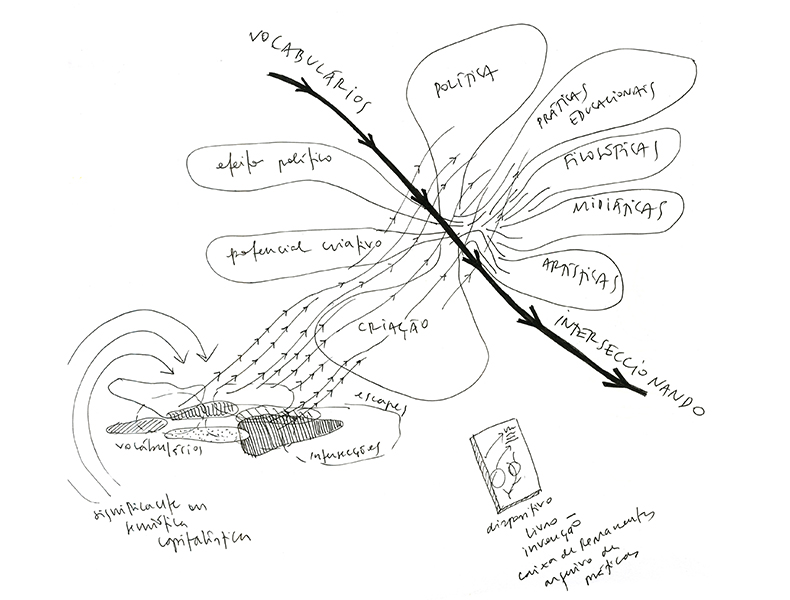
Drawings/diagrams of the process. Cristina Ribas, 2014.
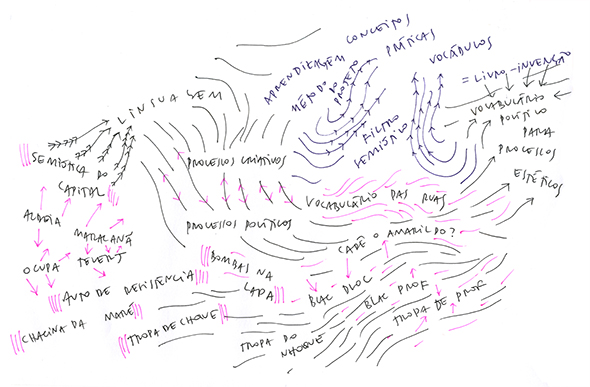
Drawings/diagrams of the process. Cristina Ribas, 2014.
2. Language, Idiom18, Financial Capitalism: Seizures and Proliferations of Meaning
Idiom, or how we communicate, how we speak (and what we speak about, if we speak) are constitutive of our lives, of the singularities that we design, and of the common realities to which we belong. Idiom, therefore, is directly related to the production of life, the production of languages and of other idioms, and the creation of other modes of expression and communication. Vocabularies, however, are part of the living dimension of idiom, and manifest themselves in our artistic and political practices. Vocabularies are shaped by multiple forms of miscegenation that expose the marks of our individualities through plural registries, such as the generation to which we belong, our gender, our familial relations, relationship to power, our work, our ethnicities, and our languages. But idioms, like vocabularies, are not directly related to speech, or to the capacity of speech as a communicative fact. Our vocabularies can – in situations of censorship, trauma and silencing – remain as non-enunciated idioms; they can remain in a dimension that is neither audible nor visible within other human expressions. Strategically, they can be neither heard nor understood, thereby remaining obscured and unsignified.
The force of intersecting vocabularies, for its part, produces enunciations: like an uncontrollable scream that opens the space in front of the body and finds other bodies to contaminate that reproduce and modulate that same enunciation. The strength of the intersection of vocabularies, like that of the social encounter, or as an Evento, as analyzed by Rodrigo Nunes in Political Vocabulary, may not only be the space of disputed meaning, but of life itself. In the context of Brazil’s recent protests, the fusion of the Black Blocs with protesting teachers in Rio de Janeiro can be thought of as an example of strength. To tell the story quickly: in October of 2013, Rio de Janeiro military police violently repressed a protest that was part of the state and municipal teachers’ strike. Black Bloc members joined the teachers in solidarity. When these Black Blocs were repressed, various new lines of solidarity were created, seen especially in two new blocs: the “Black Profs” and the “Teachers’ Troupe”. These two blocs did not allow for distinctions between teachers and Black Bloc members, which confounded police strategy and created heretofore unseen solidarity in the cycle of protests in Rio de Janeiro.

Photo: Unknown author, circulated on the internet. Rio de Janeiro, 2013.
We can identify a point of departure for the strength of intersecting vocabularies – and, on the other hand, the cause of their suppression – in the analyses of authors like Paolo Virno, Cristian Marazzi, Franco Bifo Berardi and Félix Guattari19, each of whom, in his own way, shows that linguistic production is currently subsumed by the means of capital (both cognitive and financial). This results in a brutal flattening: diminishing the potential of the proliferation of meaning in the social production of idiom.20 This does not mean that we produce less (to the contrary!), but rather that there is a semiotization of aesthetic and political production that veers away from the multitudinous proliferation that creative potential may possess as a function of meaning: the value of capital. As Berardi writes, this means that there is very little sense for a never-seen quantity of signs. And this also means, on the other hand, that we become agents of valorization.21
In recent months and years, Brazil22 has, for its own part, shown an uncontrollable proliferation of enunciations that demand democracy and the right to protest: the guarantees of basic civil rights when faced with the Brazilian state’s irresponsible spending (especially on “megaevents”23); the respect of life and of religious differences; and the end of homophobia, racism and police violence. This uncontrollable proliferation of enunciations marks the very intensive passages between political and aesthetic processes.
Faced with what I will call the “greater issue” involving the social meaning of idiom and the reproduction of value in financial capital, how can we create strategies of visibility for the vocabularies that proliferate along with our struggles, our lives and the production of enunciations in the face of macropolitics and macroeconomics? There is currently a shock between our relationship to production and the meaning of social production, exposing how capital and the state are ever more conjoined. This shock is an antagonistic conflict in which distinct positions raise their voices in a more or less territorialized, more or less normative way (such as the non-legalization of abortion and the homophobic “Family Statute”, among others). It becomes necessary to affirm that the boycott of the streets’ political forces and creators is a boycott of creative potential itself. This boycott occurs in diverse spheres, ranging from the media to the government.24
Virno’s defense of reclaiming the concept of multitude, as expressed in A Grammar of the Multitude, is worth examining here in order to consider the creative potential of life and the potential to differ with another. Virno recuperates Spinoza’s definition of a multitude that affirms “plurality” rather than massification (faced with images of the people, or the public). He writes: “Multitude is the form of social and political existence for the many, seen as being many: a permanent form, not an episodic or interstitial form”. He presents another diagram through which he conceptualizes “multitude” in the post-Fordist era, writing that:
An entire gamut of considerable phenomena – linguistic games, forms of life, ethical inclinations, salient characteristics of production in today’s world – will end up to be only slightly, or not at all, comprehensible, unless understood as originating from the mode of being of the many. To investigate this mode of being, one must have recourse to a rather varied kind of conceptual orchestration: anthropology, philosophy of language, criticism of political economics, ethics. One must circumnavigate the multitude-continent, changing frequently the angle of perspective.25
The “how” that is implicit in this section of Virno’s text is the same as the “how to do” in Political Vocabulary. This is why assembling a “vocabulary” is a proposal that is artificial, capenga26 and doubtful, but that can still operate as a productive machine. Guattari invests in the concept of machine in Chaosmosis, in an amplified conception of machine, a machine that joins itself to vital processes and becomes “desiring”, or literally, an activation of libido, producing more desire.27 From the perspective of vocabularies or the intersection between them, vocabularies can become a machine that does not belong to the “majority” of speech (of those who already have a voice, those who can speak, or those who speak in the common sense), but that is also a machine that opens listening and “bulinações”28 that arise in aesthetic and political processes, in exchanges, in creations, in the subjective transformations that break the semiotics of macropolitics, that interfere with the structure of the state’s power, and that proliferate social meanings.
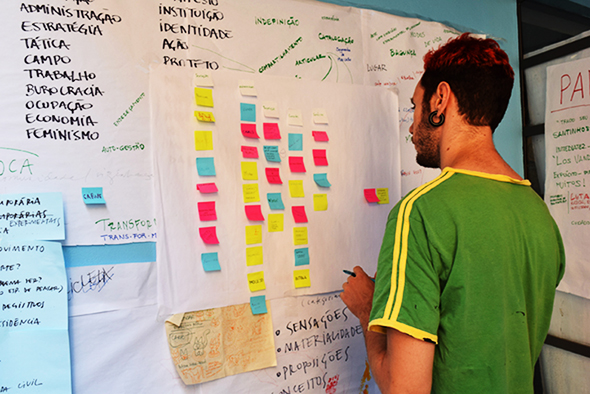
The project Vocabulário político para processos estéticos in process. Capacete, Rio de Janeiro, 2014.
3. Transversality
So, how is it then that we “made” the Political Vocabulary? Or how is it that we came to a definition of a “conceptual orchestration” – as Virno speaks of – from which we made the vocabulary? The Political Vocabulary as project put people together in a restricted time frame. We met in a series of intense workshops and discussions over the course of one week in April 2014. We were not an already constituted group from where the making of the book could begin. So how is it that we established, from my invitation, a method or a methodology to make the vocabulary? Collective processes prescind of a “how to do”. In our case, without a method we could have run the risk of finishing our “working week” without a working framework. A “how to do” is a mixture between method and strategy. I conceived, in order to start the week, a sort of framework that asked each participant to make a “proposition” to the other participants. In one way I didn’t want to over impose “methods”, and part of my expectation was to hear from the participants which methods or methodologies they would bring, intrinsic to their practices in their every day life and their collective processes. Julia Ruiz asked (problematizing!) if we would make a vocabulary that could “teach” something to aesthetic processes, and many people have suggested that the vocabulary could be the other way round: aesthetical for political processes!
Amongst several methodologies I have used myself, studying and mobilizing them in arts projects, in the University and in independent research, and thus in the political processes in which I took part, I brought to that week of work both notions of research and radical learning.29 In my practice the notion of research is very much inspired by the notion of “militant research” from the groups Colectivo Situaciones and Precarias a La Deriva.30 Both methodologies and concepts – learning and research – work together and they encounter each other also in the conception of a “multitude” (Virno) and the “processes of subjectivation” (Guattari). Precarias a La Deriva conceptualized the notion of “militant research” as:
[…] a process of re-appropriation of our capacity of creation of worlds driven by a stubborn militant decision that is not comfortable with the “a priori”, the “should be”, or old and new models… but one that interrogates, problematizes and pushes the real through a series a concrete procedures.31
In my Ph.D at Goldsmiths College (in London, UK), where I study with both eyes turned towards Brazil, I have been focusing on Felix Guattari’s schizoanalytical cartographies and four other concepts developed by him associated directly to the cartographies. They are the “ethico-aestetical paradigm”, “collective assemblage of enunciation”, “institutional analysis” and “transversality”. The “transversality” can be understood as the production of an analysis strategy (being a mode of observation, an implication, a listening, amongst other procedures). Transversality has to be able to break majoritarian aspects and open positionalities, singularizations and interventions. Following this concept and practice, I realize, allows transversal analysis in two ways: in one way it can create interventions or crossings in fields of knowledge or in different practices (crossing through practices, crossing through institutions), and in the other way, in group work, it can activate authentic speeches (or testimonies) that will possibly address an institutional analysis and that might be able to produce “cuts” in the institutions themselves.
The concept of transversality appears in Guattari’s practice of institutional psychotherapy when working in the Psychiatric Clinic La Borde in the outskirts of Paris.32 The clinic was directed by Jean Oury and was opened in 1951. Guattari had worked there since 1955, learning and collaborating with Oury on several articles. A series of transformations tested in the clinic corresponded to the movement of institutional analysis and was parallel to community health movements that was happening elsewhere in the USA, Europe and other countries (a movement known in Brazil as “luta anti-manicomial”).33 In the Clinic, Guattari and Oury developed their most significant contributions to institutional psychiatry, literally turning “upside down” some practices by creating “transversals” that could problematize the psychiatric institution in its power, control, care and therapeutic dimensions. The critique made by Guattari came from his studies on psychoanalysis, studying with Jacques Lacan and being his patient for many years. Psychoanalysis was the most common method applied all over Europe, both for individual treatment in private consultation and in the psychiatric asylums.
La Borde clinic was open to visitors, had interns, and open sessions of “institutional analysis” that used to receive militants, sociologists, philosophers and others. Guattari and Oury observed it was necessary to shift from the intern’s private treatment to a treatment that would focus on the forces of the institution itself. Moving away from the “one-to-one” therapy (analyst and analysand), they wanted to be able to detach the treatment from psychoanalytical truths (based on Oedipian triangulation), to be able to look at the collective or social production of pathologies, and, on the other hand, social production of desire. Guattari and Oury worked through the transversalization of the treatment by bringing La Borde’s patients (both the professions and the patients) to a collective session of analysis, in which the analysand was the institution itself and not the isolated patient (which does not mean that each patient stopped being taken care of case by case, or that they stopped the one-to-one therapy). Transversality requires that, in a collective session of analysis, each participant in the session, whether a healthcare provider, a patient or a visitor, revisits their own role. This happens, for example, through the analysis of each person’s symbolic role on how he or she could become an “expression of the institution’s unconscious subjectivity”. Which means, how one can simultaneously speak from a particular position and “be the institution itself”, and by analysing this “symbiosis”, produce new points of view, dislodging the power from the speeches in which it is often embedded and launching its redistribution.
Recovering those two ways by which we can put transversality into practice, in the first way as a method for collective practices, configuring an analysis on the institutions and the forms they imprint in collective formations, the second being the form through which the collective configures itself. Guattari created a distinction that is very useful between “subject groups” and “subjected groups”. The first term defines groups that are able to conceive their own mechanisms and realize their end (because they have autonomy in the conduct of their own process). The second describes groups that follow rigid methods, reproducing hierarchies. Those groups tend not to create space for processes of subjectivation that are more transformative. For Guattari, accordingly to Watson, the subject group is the one that “has managed to organize itself according to the structure of transversality”.34
The second way that I see we can put transversality into practice refers to a capacity of crossing through practices and forms, institutions and fields of knowledge. The drawing of a transversal in this case would be provoking a tension between majoritarian and minoritarian becomings, opening exchanges directly in the micropolitical field, without having to refer to the macropolitical field (where major significations reside). In this case there would be a break in the binary relation that constantly reflects practices to a structure. As an example, we can think about the proliferation of enunciations in the streets of Brazil in the cycle of Junes and how this is addressed to the majoritarian structure constituted by the Brazilian state. State control of power ignores and/or over – signifies these “minor enunciations”.
Transversality as a method, or as a systematized method that can be accessed and applied in contingent and temporary situations, can be encountered today in the definition of the “schizoanalytical cartographies” emerging from the work of Brazilian psychologists, lecturers and researchers in several. Regina Benevides de Barros and Eduardo Passos, from UFF (Universidade Federal Fluminense), explain that the cartographic method has both a clinical and a political direction, that it has a “transversality coefficient” that guarantees a communication that does not extinguishes itself in the two-dimensional axes of the socius (the vertical and the horizontal). The cartographic method, following them, is always transversal. The transversal is, indeed, the creation of a third vector that crosses through the vertical – the one that organizes difference (producing hierarchies) – and the horizontal, which organizes by affinity, putting minorities together. Barros and Passos affirm that the “political nature of the cartographic method” concerns the capacity of producing such a third vector. In the production of transversal methodologies other perspectives are rehearsed, incisions that might be able to relate aesthetic and political processes together.35
4. Methods and Methodologies: A Transformative Encounter?
In the meetings that were held for the making of the book in Rio de Janeiro we did not center our conversation around the construction of a group process in the sense of attempting to produce a collectivity, nor did we deeply exchange differing group methodologies. Several interventions and contributions by participants in the project exceeded my pre-conception of how that week of work should function and in a way where we could move on from understanding what had been the book’s pre-project. In conceiving this project and group to make the Political vocabulary, there was already thinking about the transversal practices that the participants had been developing in different fields, social constitutions and institutions. By enabling us to share our modes of production – how we work, how we perform – there could certainly be a path to investigating our vocabularies, observing similitudes and differences, that would not only be conceptual, but also show how they are expressed in our practices. Personally, my desire was that in the process of the intersection of our vocabularies, by listening to each other, we could learn with each other about our modes of doing but could also revisit our positionalities. In this sense there was a “gamble” for the encounter to be subjectively transformative.36
In different configurations, I had already worked with some of the invited participants before on common projects in the arts, such as Beatriz Lemos, Isabel Ferreira, Breno Silva and Graziela Kunsch, or I had worked with some of them in projects or groups engaged with social mobilization and political organizing (Pedro Mendes, Inês Nin, Sara Uchoa and Rodrigo Nunes). From close observation of how some of the people worked, like Juliana Dorneles, Raphi Soifer and Laura Lima, and by noticing their transformative capacity when working collectively, I wanted to invite them to be in the project. Some like André Mesquita and Julia Ruiz for example, were invited because I wanted to share with them research processes and the conceptualization of events and creative and political processes, as they do in their own research and militancy. Besides, the gathering enabled unpredictable exchanges between the participants.
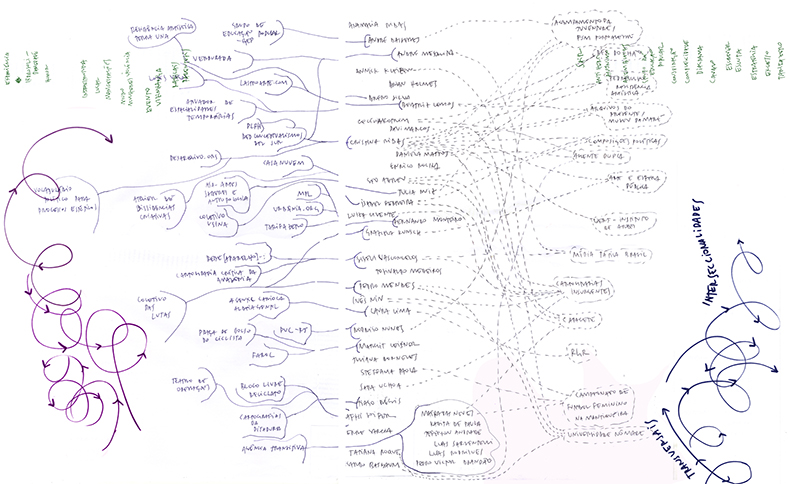
Cartography of the participants and the process. Cristina Ribas, 2014.
Amongst all the things, sensations, perceptions, collective experiences and life chronicles that emerged at the end of a week of working together, we were also simultaneously listing and diagramming the concepts that we wanted to work through in the book. “Tools” could be useful among us to establish a common working terrain, what could become at the same time content for the future book. The concepts and practices, or the vocables, literally from a vocabulary, are in the book called Entries. I remember it was André Mesquita who first classified in categories the list of vocables that appeared in our conversations. From this first mapping and classification we could start understanding not just the “inner contents of the content”, but also how they could operate. The concepts that appeared and that were more related to group dynamics, what I call the “toolbox” for collective processes, were Complexity, Experience, Hidrosolidarity, Humor, Listening, Neighborhood, responsa-ability37, Strategy, Transduction and Writing, amongst others. In the meeting the group Agência Transitiva presented their method of Check In and Check Out. It became a beautiful way of introducing speeches or testimonies that could connect to our subjective states, and it also operated as a living cartography of the participants. In the Check In and Check Out we had a precise time to say how we were feeling, what could positively work as a feedback of the collective processes we were engaged in.
“Transversality” didn’t make the book as an entry, but in our encounter it operated through me, in the way I was (or thought I was) “subjacently” catalyzing the work to be done, acting in a sort of experimental mixture of work as mediator, artist, militant investigator and curator at the same time. A mediator usually has the role of keeping the conversation inside the very specific proposition that holds the group together, of counting time and of opening space for different positionalities. My experience as project organizer and subsequently as book editor allowed me to experiment with ways of working that I hadn’t experienced before. From my previous experiences I wanted to be able to activate in myself that attentive listening, that “transversality coefficient” that should be brought by the participants as well. How could I, from my previous experiences, configure a catalyst position that would not defend any form, institution or field of knowledge given previously? How could I configure with the participants a space in which we could attentively listen to each other, that could authorize authentic positionalities, and, by listening to our multiple desires, could give shape to a plural vocabulary? How could I not try to maintain a neutral position (is it even possible to be neutral?), but rather one that could be active, catalytic (increasing heat, contact, relation) and bulinadora (an inciter).
In order to guarantee the encounter in its transformative potency we should, in the analysis of our discourses, be able to dislodge or displace our points of view, open ourselves to confront our perceptions and concepts to other perceptions and ways of living that could be different, even if making use of the same concept (the same noun!) or practice. That would be a way of putting transversality into practice. And that did indeed happen. It was important, for example, when Juliana Dorneles proposed making a dynamics that would start with a one-to-one dorsal spine massage and unfold into a moment of writing. She asked us how we could produce from other places. These other places, I saw, would not be relying on discursive, narrative, analytical or verbal exchanges from our concepts and practices. In this sense, enlarging what Julia asked about the aesthetic processes that could “learn with” political processes, I see that what we could “learn with each other” was very important. The notion of “learning” here would have to be inflected, however, to the processes of subjectivation, to the transformational processes and to what it is that makes a position shift beyond attentive listening. It seems that one cannot come out of a process with no record whatsoever of what was being said, with no affectation. I believe that the possibility of producing transversally comes from the ability of disconnecting from the very majoritarian identitarian factors in the constitution of a subject (and of a struggle). The necessity of producing an identity is, however, one of the mechanisms of political resistance. This disconnecting could give space to other perceptions of one’s majoritarian factors, which could connect us in different minoritarian aspects. That might mean leaving a mode of production or signification of the production in a specific field or discourse in order to occupy other spaces that are more complex, more problematic, more hybrid, uneasy to be defined and circumscribed. This is a total strategy. This strategy dislodges, for example, the understanding of the aesthetic effects of creativity. What new spaces for creative affect and aesthetic effect can emerge from that?
The process of making the book incited, therefore, numerous displacements. Some of us came out of the meeting very confident “about what” or “how” the contribution to the book would be (written, drawn or diagrammed). Some of us left with a well consolidated sensation of what the contribution would be, which later came to be the content itself assuming a form, recovering some of the threads of the content-diagram we worked on throughout the week. But the process of the book also incited contributions that took a while to arrive, taking longer because they had to gain sense, they had to occupy a body, and those especially called me to continue the process of attentive listening, reconfiguring in each situation the catalyst-editor in relation with the vocabulosos-writes. In this process of the transformation of content taking shape, other transformations emerged. One of those was the process of replacement facing that displacement, a certain kind of Transduction that operated together with the desiring production, with the desire of operating new listenings, new readings and new “out loud readings”.
It is clear that each methodology has escape routes. That each productive methodology cannot restrict a process to the point of freezing it. That is why what emerges here is a “bastard vocabulary”, as was said by a friend when he saw the book – a vocabulary that emerges from the collection of multiple voices that often talk together, in unison. Maybe the book is the result of a process in which some allowed themselves to bulinar more to each other, allowing an entering into a creative and political estate. That is why it is not worth describing here the project in a way that the description serves only to justify a process, as an incarcerated memory of the process, where we can identify plenty affects but few effects. I perceive that what is worthwhile in the process of provoking transversals is the continuous analysis of the productive way by which each Entry appeared, so from this we can imagine and desire other intersectionalities.
I finish this text with a narrative of some of the experiences of the participants and their writing processes, then connect with actual dimensions of these experiences, being the participants more or less connected to social struggles and the Disruptive Junes.
5. The Invention-Book and A Few Intersections
Now that the book is launched it is as if an attention to the future has opened, a future of the invention-book. The future of the book is the meetings, the talks, the social spaces in which the book will participate. With the finishing of the book a “scan” takes place of “what is it that this invention-book is making” or might be “making-desire” today in the political spaces and in the spaces for creativity, and above all in the spaces in which politics is enabled by a creative capacity as well. In this sense, as already noted, it is possible to operate an inversion of the name of the project, as many people have suggested. Aesthetical vocabulary for political processes. What the political processes can “learn” from aesthetic processes is exactly the capacity of activating singularities and intersectionalities, of activating a creative dimension that is inherent to life itself.
In this sense, I create an analogy with a former conception of history to think about what sort of relevance aesthetic processes are taking in the lifes of those enunciating themselves in the spaces of the streets. History in a conservative cenception might act as a mechanism that blocks changes in social processes, as an indelible horizon. For the arts this mechanism could be the notion of spectacle. In the streets of Brazil, definitely it was another spectacle that became present – it was a cut in the political time, as said by Pélbart, made by those “who are no one”. A forcefield is open, without stage, where tireless producers of a “minor Brazil” announce themselves. The “minor” Brazil would be the one that affirms itself facing the “major” Brazil forcibly produced by the State and its economical policies.
To end this analytical and visual cartography I bring four Entries that prolong intersectionalities in the actuality of a “minor Brazil”.
Giseli Vasconcelos has written the Entry Hidrosolidariedade. Hydrosolidarity is a sort of “soluble solidarity (…)”, it comprises “collaborations and associations”. The Entry is literally a dive into the geography of the Amazonian region, and why not a cartography, that passes by Oswald de Andrade’s38 journey to the constitution of the rede [aparelho]: network. The network puts together hackers, artists and teachers, amongst others around the city of Belém. Giseli was one of the organizers of the project Amazonian Critical Cartography, a mapping project that developed a series of activities in the Amazonian region, creating tools for mapping and publishing an homologous book at the end. Giseli levers a plural vocabulary that “wets” itself in the Amazonian geography, from the sensibility of sweating in wet lands. Facing that, I look at this vocabulary without being able to forget the developmental projects that de-configure the region.

Tool of Oxum. Feminine Orixá that rules love, intimacy, beauty, wealth and diplomacy of fresh river waters.
The Pocket Cyclist’s Square was built with many hands – and why not with pedalling as well – in Curitiba in the recent years. Margir Leisner took part in the encounter in Rio and initially had a proposal for the book that ended up not formalized. She wrote about the building of the Pocket Cyclist’s Square after an e-mail conversation between me and her. Margit had doubts about what kind of contribution could be effective for the book. She did not center her presence in the encounter around her participation in the building of the square, however. In the e-mail exchange we talked about the collective process that she was undergoing in Curitiba and how rich it was as a processes associating political and aesthetical effects. Margit was also part of the movement resisting the destruction of Bosque da Casa Goom, a similar case to Augusta Park. Augusta Park is a green space in the heart of São Paulo that could have been transformed into a public park, however, instead it is going to host the construction of three residential towers. The construction of the towers extinguishes part of the microclimate held by the forest. It will extinguish as well some of the practices that were developed there but that will certainly reappear in other processes of resistance.
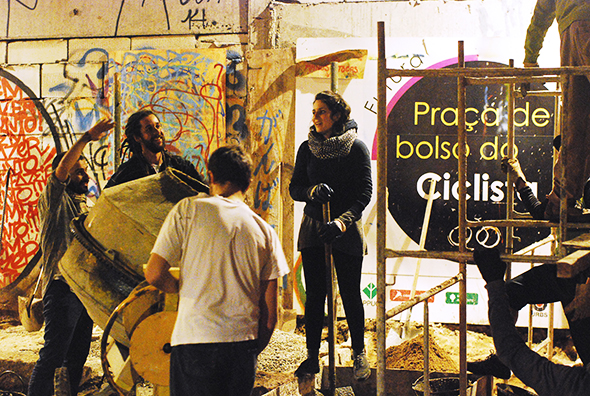
Photo: Doug Oliveira, Curitiba, 2014.
Enrico Rocha reports in the text Neighborhood its relation with the Poço da Draga (Well of the dredge), a district at the border of the sea in the city of Fortaleza. The Poço da Draga appeared in the construction of one of the docks in Fortaleza in the beginning of the century, secreting an empty area that was slowly occupied by fishermen for the construction of their houses. In the text Enrico makes a beautiful report of his affective and political relationship to the Poço da Draga. He tells us about the possibility of the community’s eviction with the construction of a big building that could become a touristic aquarium – the Acquarium Ceará project. The project is already presenting a series of economic scandals between the mayor of Fortaleza and construction companies. Amongst the various actions that have happened to support the district, at the end of April 2014 a group of artists made an exhibition in the Centro Cultural Dragão do Mar. The exhibition was part of the series of events celebrating 108 years of the community. Enrico wrote two texts for two newspapers in Fortaleza about the process. And many posters were made for the exhibition.
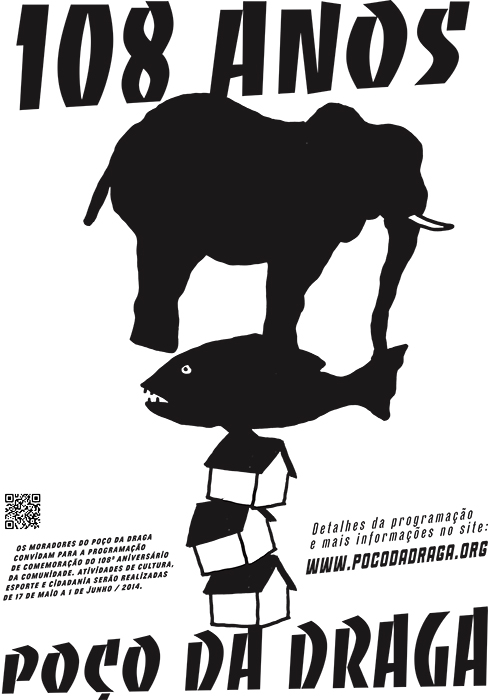
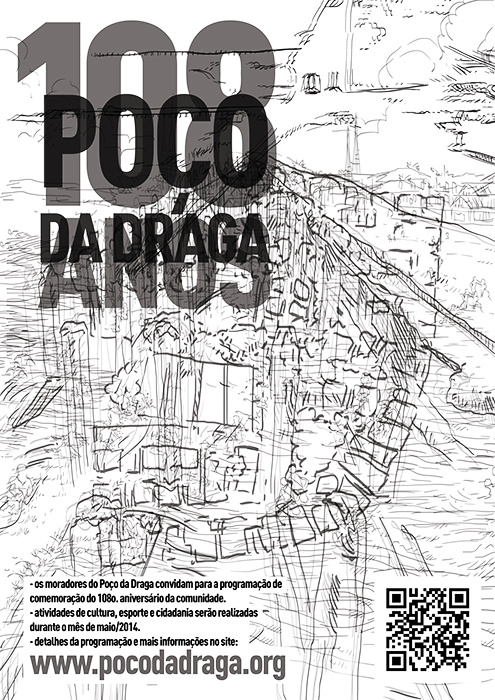
Poster by Vitor César for 108 years of Poço da Draga. Fortaleza, 2014. | Poster by Ramón Cavalcante for 108 years of Poço da Draga. Fortaleza, 2014.
Maré is a “complex” of favelas in the city of Rio de Janeiro. Maré means, in portuguese, the tide. Maré in the book is a “complex” vocable, paraphrasing the intervention made by Marcos Chaves in one of the walkways above Brazil Avenue. Amarécomplexo.39 To know Maré’s complex was one of the ideas followed in that working week, coming out of the concept that we could make propositions to each other in order to animate other modes of investigation. Weeks before our meeting, in the beginning of April 2014, a slaughter happened in Maré. A “conflict” ending with the shooting of nine people by the PM – amongst them civilians who were not involved in drug trafficking. It was the justification used by the Federal government to order the National Force to occupy Maré in order to “guarantee the safety of the inhabitants”. The occupation happened in the same week we were gathered for the Political Vocabulary. The proposition of going to Maré was made by five participants: Lucas R., Lucas S., Breno, Graziela and Jeferson. It emerged from the critical reading of the vocabulary used by the “Action protocol for security forces” produced by NGOs, orienting the inhabitants to how they should respond to the searchers from the PM and the army. The vocable Maré, in the book, became an investigative cartography and ended up aggregating several voices that talk from inside and outside the favela.40 The vocable is, however, a very small part of the much wider tide that asks for the leaving of the national forces and demands an end to PM violence. Recently, a pacific manifestation organized by the inhabitants and taking place in Brazil Avenue and Linha Amarela was heavily repressed with tear gas and gunfire.
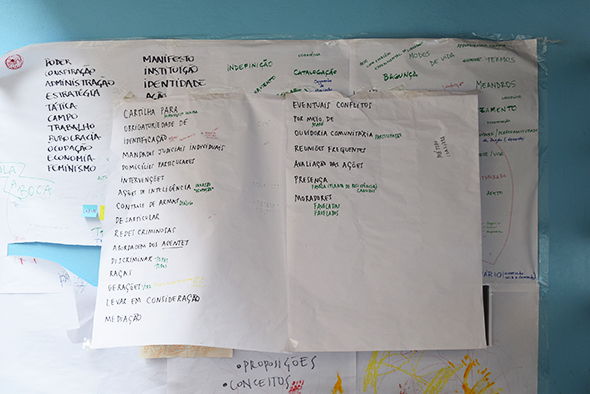
The project Vocabulário político para processos estéticos in process. Capacete, Rio de Janeiro, 2014.
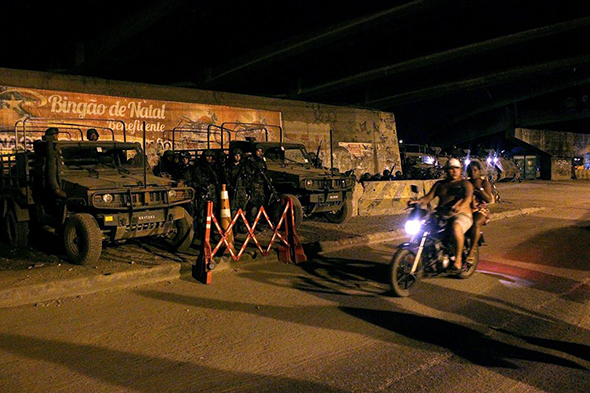
Military presence in Maré. Photo: Independent Popular Front (FIP), 2015.
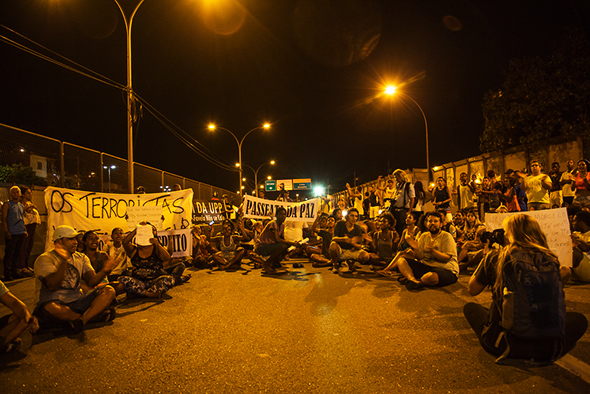
Popular protest in Maré. Photo: Katja Schiliró, 2015.
Additional Bibliography
Kastrup, V.; Passos, E. and Tedesco, S., Políticas da cognição. Porto Alegre: Sulina, 2008
Marazzi, C. Capital and Language. From the New Economy to the War Economy. New York/London: The MIT Press, 2008
–
1 http://www1.folha.uol.com.br/opiniao/2013/07/1313378-peter-pal-pelbart-anota-ai-eu-sou-ninguem.shtml
2 For more information on the cycle of protests and on contemporary Brazil, I recommend Jean Tible’s article Encruzilhadas Brasileiras: entre protestos, processos e eleições. The expression Disruptive June appears in his article. I make use of his expression here thinking the in between Junes: Dirsuptive Junes. http://nuso.org/upload/articulos/4090_1.pdf
3 http://www.mpl.org.br/
4 The participation of professionals from different parts of Brazil is one of the prerequisites for Funarte’s Redes Grant, which aims to stimulate the circulation of professionals by depolarizing central axes of production and mobilizing new productive networks.
5 Two books served as references for this project, both of which were conceived in a similar way as Vocabulário político and circulated during our encounters. They are Vocabulaboratoires (download http://desarquivo.org/node/1681), edited by Manuela Zechner, Anja Kanngieser and Paz Guevara, and Micropolíticas de Los Grupos: Para una Ecología de Las Prácticas Colectivas (download http://desarquivo.org/node/1685), organized by Oliver Crabbé, Thierry Muller and David Vercauteren. Both books are the results of encounters and exchanges, and operate both as toolboxes and as documents/archives of practices and experiences. Micropolíticas especially is organized through verbs that characterize group actions, or methodologies for micropolitical works.
6 In 2012, the Universidade Nômade (Nomad University) network compiled a lexicon entitled Ferramentas das Lutas (Tools for Struggles) http://www.revistaglobalbrasil.com.br/?page_id=1498
7 Information about these research groups can be found here: http://www.ufrgs.br/ppgpsicologia/ and here: http://www.slab.uff.br/
8 One of the reference articles on intersectional feminism that I used is Adriana Piscitelli’s Interseccionalidades, categorias de articulação e experiências de migrantes brasileiras. Revista Sociedade e Cultura, v.11, n.2, July/Dec. 2008 link http://tinyurl.com/k64nsgl
9 In choosing the term “practices” to refer to artistic, political and other practices, I want to call attention not to a specific field or linguagem, but rather to the capacity – or literally, the practical dimensions – of the actions carried out by various social actors. In this sense, for example, when I refer to artistic practices, I do not intend to concentrate solely on art undertaken by artists, but also on the artistic or creative aspects of other social practices. This, in a certain sense, is a transversalist perspective.
10 “Idiom” is a somewhat inexact translation of the Portuguese linguagem, which conveys “a grouping of capacities, signs and signals that constitute human communication, and which may include spoken, written, or gestured signs, among others.” (T.N.)
11 The participants’ biographies can be found here: http://vocabpol.cristinaribas.org/ticipantespart/
12 Luiz Camillo Osório. A few thoughts on Aesthetics and Politics. In: Transnational Dialogues 2014. Available at: http://www.transnationaldialogues.eu/
13 Amarildo was a builder and odd-job man who was tortured for no reason and killed in the Rocinha favela. The destiny of his body is still unknown, despite the recordings of cameras around the UPP station that were made public showing the police taking Amarildo in the back of their car, in July 14th 2013. http://pt.wikipedia.org/wiki/Caso_Amarildo
14 Amar é a Maré Amarildo: multidão e arte, RJ 2013 http://uninomade.net/tenda/amar-e-a-mare amarildo-multidao-e-arte-rj-2013/
15 Paolo Virno. Cuando el verbo se hace carne. Lenguaje y naturaleza humana. Buenos Aires: Cactus e Tinta Limón, 2004. pp. 46
16 Franco Bifo Berardi. The Uprising. On Poetry and Finance. New York/London: Semiotext(e), 2012.
17 Regarding this theme, it is also worth reading the text Complexidade that I wrote for the book http://vocabpol.cristinaribas.org/vocab/complexidade/
18 See Footnote 9 in the previous section.
19 I refer to Guattari’s work in the 1980s and in his final book, Chaosmosis (1992).
20 One of the texts that addresses these questions in Vocabulário político is Diagrama, by Tatiana Roque.
21 Op cit., Berardi, p.59-70. This affirmation makes me think of the meaning and economy of art fairs, projects that have been awarded the largest amounts of funding under the “Lei Rouanet” (Brazilian governmental financing laws). Art fairs “organize” a market of production and consumption of art based on a signifier: through something that can be economically interchangeable, or through art as experience in the modes that the fair accrues.
22 One of the texts I wrote for Vocabulário político is Brasil | brasiu | Brazis, a reflection on the diverse “Brazils” that exist in and from this territory.
23 See also: Who Is the Cup For? Expenses in the World Cup 2014, PACS – Instituto Políticas Alternativa para o Cone Sul http://www.boell.de/en/2014/05/26/who-cup-expenses-world-cup-2014
24 This issue can be considered in how the commercial media – newspapers and magazines such as O Globo, Folha de São Paulo, and Veja, among others – classify and diminish the potential of the “June uprisings” in Brazil. These media sources initially identified protestors as “students” (thereby isolating the general mobilization to a generational issue; “the idea of protest is part of this generation” and “it will go away”) and, soon after, as “vandals” (a “bloc” that groups activists together with the idea of rioting and marginality, and therefore considers it as being depoliticized or without considerable political propositions, and therefore an acceptable target for heavy police repression).
25 Paolo Virno. Gramática da Multidão. Para uma análise das formas de vida contemporâneas. Tradução de Leonardo Retamoso de Palma. Santa Maria, 2003, p. 5 (my emphasis)
26 InVocabulário político, capenga – a uniquely Brazilian concept that refers to something shoddy or precarious that is at once functional but constantly on the verge of giving way – is conceptualized in Raphi Soifer’s text Forense Capenga http://vocabpol.cristinaribas.org/vocab/forense-capenga
27 Felix Guattari. Caosmose: um novo paradigma estético. São Paulo: Ed. 34, 1992, pp. 45-46
28 Cecilia Cotrim brought to us in the week of the project the notion of “bulinação”. She noticed it could be “read” from the word “vocabulary”. “Bolinação” is to incite someone sexually, or to annoy someone by making jokes. From there we created the expression (to) “vocabulinar”. Since our encounter I have been working with the “bulination” as a capacity of rubbing each others vocabularies, what is also said by Annick Kleizen in her text Speechless (Mudez). We also created the term “vocabulação” bringing together “vocabulary” and “action” in English “vocabulation”.
29 These notions derive from the practice of groups drawing on Paulo Freire’s Pedagogy of the Oppressed. Groups in Europe and North America working with processes that cross militancy and arts practice such as Ultra-red have been mobilizing this concept. http://ultrared.org
30 References to the work of these groups are Notas sobre el militante investigador, 2002, and the book A la deriva por los circuitos de la precariedad femenina, 2004.
31 Precarias a la deriva. “De preguntas, ilusiones, enjambres y desiertos.Apuntes sobre investigación y militancia desde Precarias a la deriva [Madrid]”. Em: Malo, Marta (ed.) Nociones comunes: experiencias y ensayos entre investigación y militancia. Madrid: Traficantes de Sueños , 2004, p. 44.
32 “Transversality” is a key text from Guattari’s work. It can be found in several of his ontologies. Félix Guattari. Molecular Revolution: Psychiatry and Politics. London: Peregrines, 1984. pp.11-23.
33 Jakob Jakobsen, in the article The Pedagogy of Negating the Institution investigates the institutional analysis in Europe between the 60s and 70s and connects to actual struggles for education. http://www.metamute.org/editorial/articles/pedagogy-negating-institution
34 Janell Watson. Guattari’s diagrammatic thought: writing between Lacan and Deleuze. London, New York: Continuum Books, 2009. pp. 29.
35 R.B. Barros and E.E. Passos. , “A cartografia como método de pesquisa-intervenção”. In: L Escossia; V Kastrup; E. Passos Eds. Pistas para o método da cartografia. Porto Alegre: Sulina, 2009, p. 28.
36 In this text I focus on the first working week for the making of the book. This week concerns what I called the “enclosed workshop” and it took place in Capacete, Rio de Janeiro, in the second week of April 2014.
37 This is the only concept that didn’t come out as a vocable/Entry as such, but somehow was expressed in Kadija’s de crossed vocabulary
38 Andrade was one of the founders of Brazilian modernism and a member of the Group of Five. He was one of the organisers of the Semana de Arte Moderna (Week of Modern Art). Andrade wrote Manifesto Antrofágico (Cannibal Manifesto) in 1928 after a long trip in the Amazonian region, in which he discovered a much more complex country then he knew from being a São Paulo elite citizen. Cannibalism is an ode to the capacity of mixing and assimilating cultures from brazilian indigenous tribes – the “anthropophagy” indigenous people -, that he extends to Brazilian culture in general. The Manifesto becomes one of the first counter discourses to postcolonial cultural domination.
39 The intervention made by Marcos Chaves, translating literally, means “To love is complex.”
40 Maré Vive is both a Facebook page and a blog. It works as a portal for inhabitants’ testimonies, for the manifestation regarding the occupation and mistreatment they might be suffering. www.facebook.com/Marevive?fref=photo



